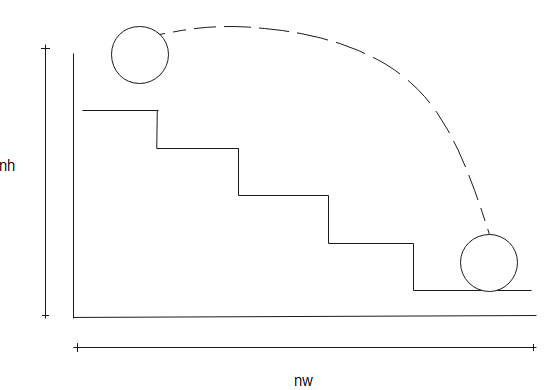Question
Question: A ball rolls off the top of a stairway with horizontal velocity \({{v}_{0}}\,m{{s}^{-1}}\). If the s...
A ball rolls off the top of a stairway with horizontal velocity v0ms−1. If the stairs are h metres high and w metres wide, the ball will hit the edge of nth step, if
(A). n=gw22hv0
(B). n=2hgwv02
(C). n=gw2hv02
(D). n=gw22hv02
Solution
The ball follows projectile motion down a stairway and stops when it hits the nth stair. The distance covered by it in vertical direction will be nh and the distance covered horizontally will be nw. We can use the properties of a projectile motion to determine the value of n.
Formulas used:
y=xtanθ−v02cos2θgx2
Complete step-by-step solution:

The ball follows a projectile motion down the stairway. If the height of one stairway is h metres, then the total height travelled by the ball will be nh metres (n is the number of steps the ball travels down). Similarly, the horizontal distance travelled by the ball will be nw metres.
We know the equation of trajectory in a projectile motion is given by-
y=xtanθ−v02cos2θgx2
Here,
y is the distance travelled along the y-axis
x is the distance travelled along the x-axis
g is acceleration due to gravity
θ is the angle made by the trajectory
At the point where the ball strikes the nth step, θ=0
We substitute given values in above equation to get,
nh=nwtan0−v02cos20g(nw)2⇒nh=v02gn2w2∴n=gw2v02h
Therefore, the value of n where the ball hits the step is gw2v02h. Hence, the correct option is (C).
Additional Information:
In order to study projectile motion, we break into two motions along x-axis and y-axis which are independent of each other. We can apply the equations of motion in both directions separately and calculate various parameters like total height covered, h=2gv02, range; R=gv02sin2θ etc.
Note:
When an object follows projectile motion, it covers distance in x-axis as well as y-axis, it moves in a parabolic path. The velocity is resolves in both directions; velocity against x-axis remains constant throughout the trajectory. At the highest point of trajectory, the velocity is zero. While at the lowest point, the velocity is maximum.
